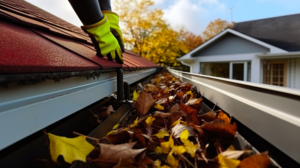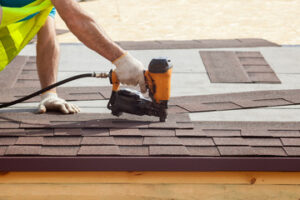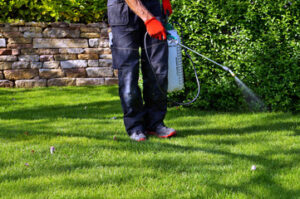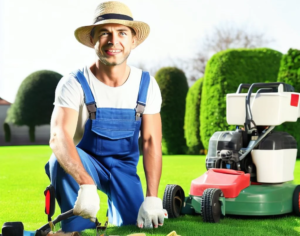Roof Cleaning Summerville SC is a critical home maintenance task that keeps a house in good condition. It eliminates unsightly stains and prevents the growth of mosses and algae, which can prematurely age shingles.
Various methods of roof cleaning exist, including power washing and chemical treatments. Each method has its pros and cons.

Keeping your roof free of debris is crucial to the health and longevity of your home’s roofing system. Debris can trap moisture and encourage the growth of mildew, mold, and other organic stains, damaging your roof over time and reducing its lifespan. Regular roof debris removal helps prevent these issues and avoids the need for expensive repairs or replacements.
A clean roof can also help maintain your home’s energy efficiency and reduce heating and cooling bills. It’s important to remove leaves, twigs, and pine needles, which can block sunlight from reaching your home and lead to heat loss. In addition, clogged gutters can interfere with water drainage and cause basement flooding and foundation damage.
Using the right tools and taking the necessary safety precautions can help you safely clear debris from your roof. The most important tools include a sturdy ladder, a roof rake, and a garden hose to wash away loose debris. When removing debris, try to do so during daylight hours and on days that are not windy to prevent it from blowing back onto the roof.
You should also examine your roof during debris cleaning for signs of wear and tear. Check for rotting shingles or flashings, and replace any that are damaged. You should also water-test your gutters and drain systems to ensure that moisture is able to escape properly. A thorough inspection can help you spot potential problems before they become major problems, and it’s a good idea to do this at least twice per year.
Heavy debris accumulation can put additional weight and stress on your roof, which can weaken the structure and lead to sagging or collapse. If you notice these signs, it’s important to have the debris removed as soon as possible to prevent structural damage. A professional roofer can help you determine the best way to remove debris and protect your home’s value and investment. They can also provide you with a detailed list of maintenance tasks that should be done regularly, and they can inspect and repair any damage to your gutters and downspouts.
Water Removal
In addition to being an eyesore, moss and algae can strip away the protective oils from shingles, allowing water to seep under them and eventually damage the structure of your home. Moss, mildew, and lichen can also clog gutters and downspouts, leading to standing pools of dirty water around your home. Over time, these contaminants can work their way into your rainwater tank, leading to contamination of the water you use to drink and wash. Regularly cleaning your roof and gutters will prevent the build-up of these contaminants.
Choosing the Right Cleaner
There are many different cleaners on the market that claim to remove moss, algae, and mildew from your roof. Some are more effective than others, but all should be used with care and in accordance with the manufacturer’s instructions. Using too much pressure when washing your roof can damage shingles and cause water leaks into the home.
It is advisable to hire a professional roof cleaner to carry out the cleaning process, as they have the knowledge, skill set, and equipment to safely and effectively remove these contaminants from a shingle roof. A professional will use a soft wash system, which uses a specialist detergent to loosen and dissolve dirt and grime before being rinsed off with low-pressure water.
Before beginning the cleaning process, it is essential to ensure that your ladder is positioned on a stable surface and that the area surrounding the base of the ladder is clear to allow for safe access to the roof. Similarly, it is important to check the weather before starting the cleaning process, as high winds or rain can cause accidents and may affect the effectiveness of the wash.
It is also a good idea to disconnect any down pipes before carrying out the roof cleaning process. This will prevent debris, such as leaves and twigs, from being washed into the rainwater tank during the wash process. Additionally, it is important to inspect the gutters and downpipes for any blockages or signs of damage before starting the wash to prevent debris from clogging the gutters.
Chemicals
There are a number of chemical cleaners specifically formulated for use on roofs to eliminate stains and to kill organic growth such as mold, mildew, algae, and moss. These cleaners are typically sprayed on the surface of the roof at a pressure not to exceed 100 psi to kill the growth and remove the unsightly build-up. Many of these cleaners can also be used to clean the gutters and shingle siding in addition to the roof.
One of the most common and effective chemicals for cleaning roofs is sodium hypochlorite (bleach). This chemical is an oxidizing agent as well as a disinfectant and works by breaking down the organic material on the surface. It’s a strong solution, but it must be diluted to avoid damaging the roof and surrounding vegetation. It’s also highly toxic and breathing the vapors can cause coughing, lung irritation, and shortness of breath.
Another popular chemical for cleaning roofs is sodium hydroxide, also known as caustic soda. This solution is a powerful alkaline and a good deep cleaner. However, it’s corrosive and can damage the surface of the roof shingles as well as any other roofing materials. It also requires proper dilution and the use of protective gear to prevent chemical burns.
Other chemicals for cleaning roofs include trisodium phosphate, ammonium sulfate, and benzyl alcohol. These are less harsh than bleach-based cleaners and can be diluted with water to achieve desired results. They’re safer for nearby plants and are effective at removing moss, lichens, and staining caused by bacteria or fungi.
The article does a great job of highlighting the benefits and safety precautions of chemical cleaning. It’s important for homeowners to know that this is an option to consider for their home and that it can significantly extend the lifespan of their shingles. It’s also a great option to keep in mind if you’re looking to sell your home and want to make it look its best. With the right professional and proper application, this can be a game-changer for your home’s appearance and longevity. The key is finding a company that knows how to safely and effectively apply the appropriate level of chemicals needed to get the results you want.
Safety
The roof cleaning process itself can be dangerous for homeowners who attempt the job without proper training or equipment. The use of high-pressure washing can damage roofing materials and dislodge shingles, while the application of chemical solutions can pose health complications for those with respiratory conditions. Additionally, working on a ladder in wet or windy weather can significantly increase the risk of accidents and falls.
To mitigate these risks, it is essential to plan and prepare the worksite before beginning the actual roof cleaning process. This includes ensuring that the ladder is securely positioned on flat, stable ground and extended to a point that extends three feet over the edge of the roof. Using ladder stabilizers and having someone stationed at the base of the ladder can also help reduce the risk of falls while cleaning the roof. In addition, it is recommended to wear non-slip shoes, a safety harness attached to a stable anchor point, and gloves to protect the hands from sharp edges and chemicals.
It is also important to take precautions to protect surrounding vegetation and landscaping from runoff water and cleaning solution. For example, if you have a lot of flower beds or bushes that are close to the house, it is advisable to cover them with tarps during the roof cleaning process. This will help prevent runoff chemicals from contaminating the plants and potentially killing them.
In addition, if you have any trees or limbs near the house that are prone to falling debris during the cleaning process, it is a good idea to trim them prior to cleaning. This will minimize the risk of injuries and property damage while removing loose branches, leaves, and other debris.
Finally, it is a good idea to clean the gutters during the roof cleaning process, as this can prevent clogging and water backup that may damage the roof over time. In addition, a final inspection of the cleaned surface can identify any areas that require repairs to avoid future problems like leaks or structural damage. This will allow you to make necessary repairs in a timely manner, avoiding the cost and inconvenience of a major roof repair.








